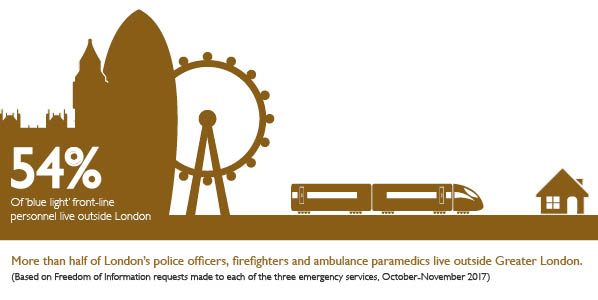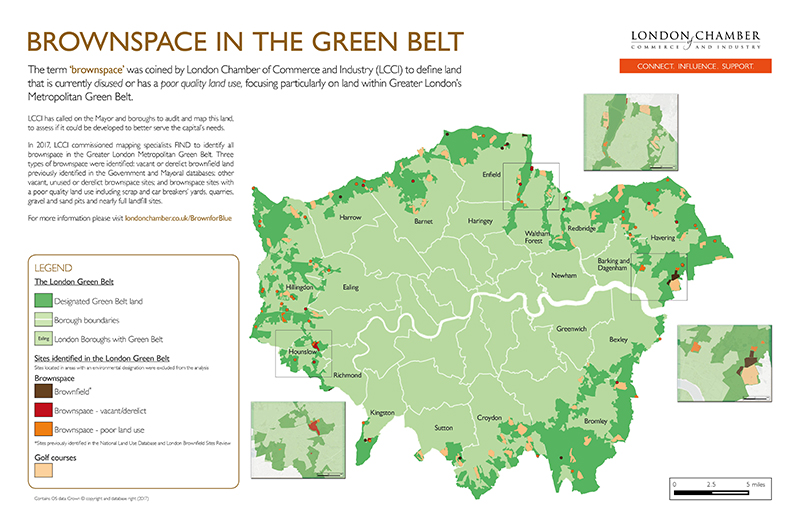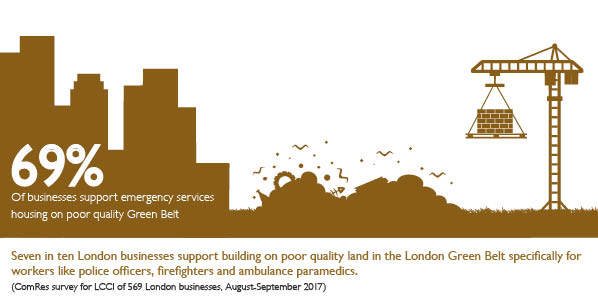In June 2016 LCCI published Living on the Edge: Housing London’s Blue Light Emergency Services which found that the majority of London’s essential, front-line ‘blue light’ emergency services personnel – police officers, firefighters, ambulance paramedics – live outside Greater London.
LCCI’s new report Brown for Blue: Land to House London’s Emergency Workers builds on that report, and finds that the key issues remain: 54% of front-line ‘blue light’ personnel live outside Greater London, often due to the capital’s high cost of living, which according to emergency service representatives can impact upon stress levels, recruitment and retention as well as the city’s resilience.

The report also finds that alongside this need for housing for the emergency services, there is still land in London that is not contributing much, if at all, to London’s needs; including ‘brownspace’ in London’s Metropolitan Green Belt.
LCCI has long called on the Mayor and boroughs to audit and map disused and poor quality ‘brownspace’ land in London’s Metropolitan Green Belt, to assess if it could be developed to better serve the capital’s needs.
LCCI commissioned mapping specialists FIND to identify this land. A total of 329 hectares of brownspace was identified, which could provide space for up to 20,000 homes for emergency services personnel. That is less than 1% of the London Green Belt.

LCCI proposes that consideration is given to using a small portion of ‘brownspace’ in Greater London’s Metropolitan Green Belt for the specific need of affordable housing to rent, for London’s blue light emergency services.
We realise making mention of ‘building’ and ‘Green Belt’ is contentious. However, the proposal is for a limited intervention, with suitable safeguards, while there is support for this amongst the capital’s business community.

Utilising brownspace sites for ‘blue light’ housing would under current planning rules be problematic. The National Planning Policy Framework (NPPF) limits development in the Green Belt, and Green Belt boundary reviews do not have to consider the quality of the land – just whether the Green Belt still performs the five purposes of Green Belt. And even then, boundaries can only be reviewed in ‘exceptional circumstances’.
Consequently, many boroughs do not conduct Green Belt reviews, and – despite the housing crisis – hardly any put land forward for de-designation and development.
This is why we think the Mayor should seek to utilise ‘brownspace’ within the Metropolitan Green Belt in London to support housing for London’s emergency services workers – so they can actually live within the capital they serve.
Thereby, the mayor and his team should focus on two principal considerations:
1) That the new London Plan should identify a ‘need’ for housing provision for front-line staff in the police, fire and ambulance paramedic services – in a similar way that previous reviews of the London Plan concluded there was a need for housing provision for older people and students.
2) That the volume and location of brownspace land within those London Boroughs that have Metropolitan Green Belt within their confines, be collated by the GLA and the feasibility of its utilisation to build homes for rent by frontline staff in the police, fire and ambulance paramedic services be examined.
For more information please find a copy of the 'Brown for Blue' report.